Mulberry: [Planting, Care, Irrigation, Substrate, Pests and Diseases]
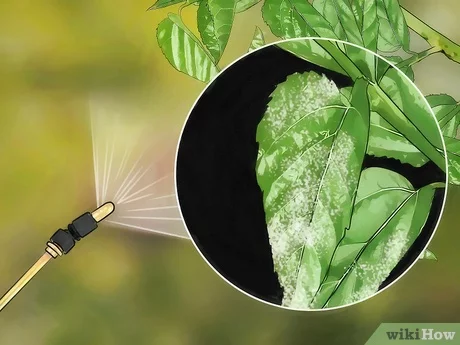
The mulberry belongs to the genus morus, and they are perennial woody plants, low to medium in size, semi-deciduous in tropical conditions, fast growing, monoecious or dioecious, and with a deep root system.
Most of the mulberry species, of the Moraceae family, have a rounded and branched crown, with a trunk with grayish bark that can measure up to 60 cm in diameter.
Important points when planting a mulberry tree
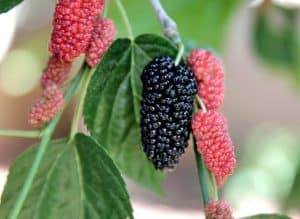 Where to sow? Full light. It needs a lot of sunlight.
Where to sow? Full light. It needs a lot of sunlight.- When? In spring or autumn, by seed and at the end of winter by cutting.
- How do we prepare the land? Removed, removing weeds. Withorganic matter substrate combined with soil.
- How do we water? With drip.
- How often do we water? In summer 4 to 5 irrigations per week. Rest of the year once every 4 to 5 days.
- Plagues and diseases? Aphid, Cochineal. fungi or nematodes.
Characteristics of the mulberry tree
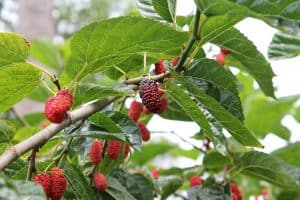 The leaves of the mulberry tree are alternate, petiolate, simple, intact, shiny and stipulated with 1 to 5 lobes, with a hairless upper surface, and a slightly tomentose underside in the axils of the main veins.
The leaves of the mulberry tree are alternate, petiolate, simple, intact, shiny and stipulated with 1 to 5 lobes, with a hairless upper surface, and a slightly tomentose underside in the axils of the main veins.
It is known as the main food source for silkworms. Due to the length of its branches and large number of leaves, perfect for providing shade, in summer times where the sun’s rays are more intense.
Also, the mulberry is considered a fast-growing tree. Under the right conditions, it can grow several meters in just a few years.
When to plant a mulberry?
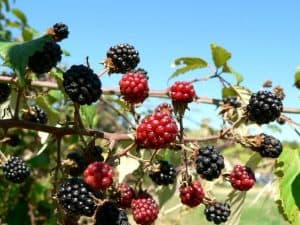 Mulberry trees are planted in the garden at the end of winter, although cultivation can also be carried out in autumn if the weather presents mild frosts.
Mulberry trees are planted in the garden at the end of winter, although cultivation can also be carried out in autumn if the weather presents mild frosts.
Mulberry cultivation is ideal for areas that experience cold temperatures in winter and hot temperatures in summer. It practically supports everything, it is for this reason that they have spread to all parts of the world.
And, although there is no special season to plant, the general rule is to do it when the conditions are favorable.
Mulberry should not be planted when the ground is frozen, when daytime temperatures are below 32°F (0°C) or above 90°F (32°C), or in extreme weather such as snowstorms or torrential rains.
Where to plant a mulberry?
This plant likes light, therefore the mulberry will grow faster and healthier when grown in full sun , where it will happily exercise its protective function.
How to prepare the land?
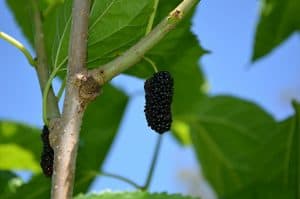 The mulberry is a tree that withstands all types of soil without resisting. However, it prefers them well aerated, to avoid suffocation of the roots, and with a neutral pH.
The mulberry is a tree that withstands all types of soil without resisting. However, it prefers them well aerated, to avoid suffocation of the roots, and with a neutral pH.
However, and although it is associated with poorly fertile land, the conditions for its fruits to reproduce are not the best when the land is weak.
The favorite soils of the mulberry are those that allow good ventilation of its rhizomes, so a neutral acidity will be the most indicated.
Mulberry trees require a good drainage system. That is why it is important to make sure that they are not located in an area where flooding is common, since they do not tolerate being covered by water.
Preferably, it is recommended to choose for the morer; deep, well-drained soils with slightly acidic soil with a pH of 5.5 to 6.5. Also, they can tolerate moderately alkaline soils.
How do we water mulberry trees?
 The irrigation of the mulberry will also depend on the climate where the crop is located, but in general it is recommended to water 4 to 5 weekly irrigations in the hottest time of the year and once every 4 to 5 days the rest of the year.
The irrigation of the mulberry will also depend on the climate where the crop is located, but in general it is recommended to water 4 to 5 weekly irrigations in the hottest time of the year and once every 4 to 5 days the rest of the year.
It is very important to be very careful and attentive when watering the mulberry tree, ensuring that the water reaches the roots well.
It will need moderate watering, always preventing the soil from becoming muddy. In fact, it could affect the mulberry rhizomes and cause diseases. It tolerates droughts although they slow down its growth.
For other horticulturists, the mulberry tree should be watered much more when it is young, although moderately. Then he’s probably enough for himself.
How to plant a mulberry step by step?
The reproduction of the mulberry is very simple since it reproduces in a simple way by cutting or seeds.
However, to preserve the characteristics that favor them so much in the parent plant, the mulberry is usually multiplied by cuttings.
Cultivation by seeds
By seeds it will reproduce in spring or autumn and it is recommended:
- Fill a forest seedling tray with universal growing substrate.
- Water consciously.
- Place a maximum of two seeds in each alveolus.
- Cover with a thin layer of substrate.
- Sprinkle copper or sulfur to prevent the appearance of fungi.
- Finally water with a sprayer.
- Place the tray of seedlings outside in semi-shade.
- If the whole process was carried out correctly, the mulberry will germinate in about a month.
Reproduction by cuttings
In the case of reproduction by cuttings, the following steps must be followed:
- Cut a branch that is 10 to 20 cms. that has about three buds (protuberances from which the leaves sprout).
- Remove the basal leaves that are the lower ones, if any.
- Impregnate the base of the cuttings with homemade rooting.
- Plant in individual pots with universal culture substrate.
- After a month or so, they will emit their roots.
What favorable associations does it have?
The association of crops of compatible plants produces benefits with respect to their cultivation separately, in addition to the use of light, water and/or nutrients.
There are no known studies on the favorable associations of mulberry cultivation.
What pests and diseases can attack our mulberry trees?
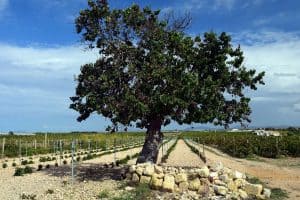 In mulberry trees there is no need to worry about pests, although some minor episodes could be observed with the appearance of aphids or cochineal.
In mulberry trees there is no need to worry about pests, although some minor episodes could be observed with the appearance of aphids or cochineal.
As precautionary measures, it is recommended to be very careful with the needs of the mulberry tree in terms of light, water and nutrients. The correct location of the plantation will be essential.
If you find pests or diseases in the mulberry tree, you should start using organic products. To kill insects, it is recommended to apply potassium soap or Neem oil or a combination of both products.
If the mulberry is still young, a simple treatment backpack will suffice to reach all its branches: Distribute the insecticide well to be effective and perform between 3 and 4 treatments spaced, for at least two weeks.
Root diseases (fungi or nematodes) do pose a serious risk to mulberry. The best thing to do against this is prevention: therefore, excessive humidity in the soil must be avoided. It is interesting to use a natural fungicide.
How long does a mulberry tree live?
Mulberry trees are long-lived fruit trees that can be estimated at up to 150 years.
How long does it take to grow a mulberry tree?
The growth period that the mulberry takes depends a lot on the environmental conditions, varying from 3 to 5 years.
How long does it take to produce fruit?
It will be a productive plant from 5 years of life. In some cases it could take up to 10 years.
Can it be grown in a pot?
There are no problems when growing a mulberry in a pot. In fact, many people have it and enjoy harvests at the right time.
How many times does a mulberry produce fruit?
It is a constant production plant that can give up to 3 or 4 harvests in the same year.
Should a mulberry be pollinated to obtain fruit?
Pollination occurs by the action of the wind, which is responsible for transferring the pollen between the flowers of the same specimen, since these are monoecious.
How cold can a mulberry tree tolerate?
It is capable of tolerating cold and occasional and short-lasting frosts that reach a maximum of -18° C.
How many mulberry trees can be planted per hectare?
Due to its small size, the sowing density of the mulberry allows the establishment of up to 15,000 plants per hectare.
What kind of fertilizer does a mulberry tree need?
Homemade organic fertilizers give very good results in the production of mulberry trees, so they can be used without problems.
This includes compost, manure and guano, for example.
How much heat and/or drought can a mulberry tree tolerate?
It is a plant extremely resistant to high temperatures, being able to survive even at 40° C.
It is also drought tolerant.
Bibliography and references
- Maria G Medina: Garcia Danny; Pedro Moratinos; Cove, Louis. (2009, December) Mulberry (Morus spp.) as a forage resource: Advances and research considerations. Reproduced from: http://ve.scielo.org/scielo.php?script=sci_arttext&pid=S0798-72692009000400001

![Photo of 4 Avocado Pests and Diseases: [Causes and Solutions]](https://www.complete-gardening.com/wp-content/uploads/2022/08/4-avocado-pests-and-diseases-causes-and-solutions-390x220.jpg)
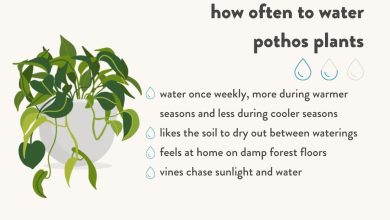
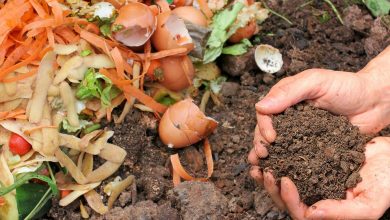
![Photo of Populus Tremula: [Cultivation, Care, Pests and Diseases]](https://www.complete-gardening.com/wp-content/uploads/2022/08/populus-tremula-cultivation-care-pests-and-diseases-390x220.jpg)